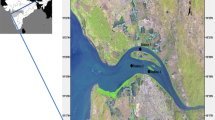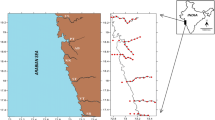Abstract
Organic detritus of the Cochin Backwater (India) is largely composed of fine silt and sand particles around which organic matter adheres and forms aggregates. In addition to plankton, large quantities of benthic algae, rooted plants, animal matter, suspended soft mud and the material brought down by the rivers and land runoff constitute the main sources of detritus. Detritus sedimentation in the estuary attains its maximum from April to June. Detritus forms a major portion of seston, while phytoplankton productivity constitutes 0.1 to 1.0% of settled detritus. Detrital pigments include degraded chlorophyll (phaeophytin), which has a marked seasonal variation; detrital carbon, phosphorus and nitrogen show little change during the year. The caloric value of detritus, calculated from protein, carbohydrate and lipid fractions and also from total carbon, indicates that sedimented detritus does not have a high nutritional value. However, being a readily available material, its entry into the food chain seems to increase the efficiency of energy transfer from one trophic level to another.
Similar content being viewed by others
Literature cited
Biggs, R. B. and C. D. Wetzel: Concentration of particulate carbohydrate at the halocline in Chesapeake Bay. Limnol. Oceanogr. 13, 169–171 (1968).
Brawn, V. M., D. L. Peer and R. J. Bentley: Caloric content of the standing crop of benthic and epibenthic invertebrates of St. Margaret's Bay, Nova Scotia. J. Fish. Res. Bd Can. 25, 1803–1811 (1968).
Buchan, S., G. D. Floodgate and D. J. Crisp: Studies on the seasonal variation of the suspended matter in the Menai Straits. I. The inorganic fraction. Limnol. Oceanogr. 12, 419–431 (1967)
Darnell, R. M.: Trophic spectrum of an estuarine community, based on studies of Lake Pontchartrain, Louisiana. Ecology 42, 553–568 (1961).
—: Organic detritus in relation to the estuarine ecosystem. In: Estuaries, pp 376–382. Ed. by G. H. Lauff. Washington, D. C.: American Association for the Advancement of Science 1967.
Fox, D. L.: Comparative metabolism of organic detritus by inshore animals. Ecology 31, 100–108 (1950).
— and E. F. Corcoran: Marine leptopel, its recovery, measurement and distribution. J. mar. Res. 11, 29–46 (1952).
Gordox, D. C.: Some studies on the distribution and composition of particulate organic carbon in the North Atlantic Ocean. Deep Sea Res. 17, 233–243 (1970).
Holm-Hansen, O., J. D. H. Strickland and P. M. Williams: A detailed analysis of biologically important substances in a profile off southern California. Limnol. Oceanogr. 11, 548–561 (1966).
Kenchington, R. A.: An investigation of the detritus in Menai Straits plankton smaples. J. mar. biol. Ass. U.K. 50, 489–498 (1970).
Krey, J.: Der Detritus im Meere. J. Cons. perm. int. Explor. Mer 26, 263–280 (1961a).
—: The balance between living and dead matter in the ocean. In: Oceanography, pp 539–548. Ed. by M. Sears. Washington, D. C.: American Association for the Advancement of Science 1961b.
—: Die mittlere Tiefenverteilung von Seston Mikrobiomasse und Detritus im nördlichen Nordatlantik. Kieler Meeresforsch. 20, 18–29 (1964).
Menzel, D. W. and J. H. Ryther: The composition of particulate organic matter in the western North Atlantic. Limnol. Oceanogr. 9, 179–186 (1964).
Newell, R.: The role of detritus in the nutrition of two marine deposit feeders, the prosobranch Hydrobia vulvae, and the bivalve Macoma balthica. Proc. zool. Soc. Lond. 144, 25–45 (1965).
Parsons, T. R.: Suspended organic matter in sea water. In: Progress in oceanography, Vol. 1, pp 205–239. Ed. by M. Sears. Pergamon Press 1963.
— and J. D. H. Strickland: Oceanic detritus. Science, N.Y. 136, 313–314 (1962).
Phillips, A. M. Jr.: Nutrition, digestion and energy utilization. In: Fish physiology, Vol. 1. pp 391–432. Ed. by W. S. Hoar and D. J. Randall: London: Academic Press 1969.
Platt, T., V. M. Brawn and B. Irwin: Caloric and carbon equivalents of zooplankton biomass. J. Fish. Res. Bd Can. 26, 2345–2349 (1969).
Provasoli, L.: Organic regulation of phytoplankton fertility. In: The sea, Vol. 2. pp 165–219. Ed. by M. N. Hill. London: Interscience 1963.
Qasim, S. Z.: Some problems related to the food chain in a tropical estuary. In: Marine food chains, pp 45–51. Ed. by J. H. Steele. Edinburgh: Oliver & Boyd 1970.
—, P. M. A. Bhattathiri and S. A. H. Abidi: Solar radiation and its penetration in a tropical estuary. J. exp. mar. Biol. Ecol. 2, 87–103 (1968).
—, S. Wellerhaus, P. M. A. Bhattathiri and S. A. H. Abidi: Organic production in a tropical estuary. Proc. Indian Acad. Sci. (Ser. B) 69, 51–94 (1969).
Rhoads, D. C. and D. K. Young: The influence of depositfeeding organisms on sediment stability and community trophic structure. J. mar. Res. 28, 150–178 (1970).
Riley, G. A.: Organic aggregates in seawater and the dynamics of their formation. Limnol. Oceanogr. 8, 372–381 (1963).
—: Particulate organic matter in sea water. In: Advances in marine biology, Vol. 8. pp 1–118. Ed. by F. S. Russell and M. Yonge. London: Academic Press 1970.
Sankaranarayanan, V. N. and S. Z. Qasim: Nutrients of the Cochin Backwater in relation to environmental characteristics. Mar. Biol. 2, 236–247 (1969).
Seki, H., J. Skelding and T. R. Parsons: Observations on the decomposition of a marine sediment. Limnol. Oceanogr. 13, 440–447 (1968).
Steele, J. H. and I. E. Baird: Production ecology of a sandy beach. Limnol. Oceanogr. 13, 14–25 (1968).
Strickland, J. D. H. and T. R. Parsons: A practical handbook of seawater analysis. Bull. Fish. Res. Bd Can. 167, 1–311 (1968).
Trevallion, A.: An investigation of detritus in Southampton Water. J. mar. biol. Ass. U.K. 47, 523–532 (1967).
Yentsch, C. S. and D. W. Menzel: A method for the determination of phytoplankton chlorophyll and phaeophytin by fluorescence. Deep Sea Res. 10, 221–231 (1963).
Zobell, C. E. and C. B. Feltham: The bacterial flora of a marine mud flat as an ecological factor. Ecology 23, 69–78 (1942).
Author information
Authors and Affiliations
Additional information
Communicated by N. K. Panikkar, Panaji
Rights and permissions
About this article
Cite this article
Qasim, S.Z., Sankaranarayanan, V.N. Organic detritus of a tropical estuary. Marine Biology 15, 193–199 (1972). https://doi.org/10.1007/BF00383549
Accepted:
Issue Date:
DOI: https://doi.org/10.1007/BF00383549




